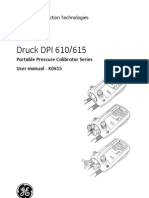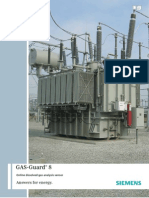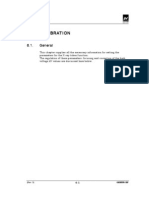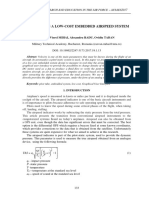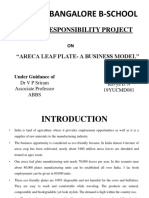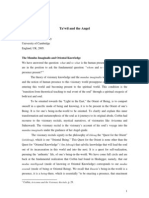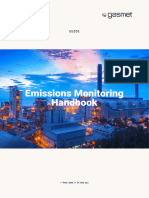Model 2700 With API
Model 2700 With API
Uploaded by
Jefferson Villalba JacomeCopyright:
Available Formats
Model 2700 With API
Model 2700 With API
Uploaded by
Jefferson Villalba JacomeCopyright
Available Formats
Share this document
Did you find this document useful?
Is this content inappropriate?
Copyright:
Available Formats
Model 2700 With API
Model 2700 With API
Uploaded by
Jefferson Villalba JacomeCopyright:
Available Formats
Model 2700 Transmitter
with Petroleum Software Option
Digital Signal Processing with MVD
Higher frequency drive
Analog, limited sampling
10 times less sensitive to signal noise
Enhanced patented algorithms
T
DSP, higher resolution
Digital circuitry
Faster Response Better Repeatability Less Parts More Reliable
Faster sampling
MVD Petroleum Software
The petroleum software version adds the following calculations to the standard 2700 software:
Calculates base density and Ctl (the correction for the effect of temperature on a liquid)
Calculates gross volume at standard temperature
Calculates flow weighted average temperature and average observed gravity (flowing density)
In order to meet the 0.5F accuracy in temperature measurement as required per API MPMS Chapter 7, an external RTD must be utilized.
The core processor must be mounted remote from the sensor in order to bring in the signal to the core processor from this external RTD.
Calculation of Base Density
The software utilizes API MPMS Chapter 11.1 to calculate the base density from the flowing density and the flowing temperature.
Base density can be calculated in degrees API at 60F, SGU at 60 F, or kg/cm3 at any reference temperature. The fluid being measured dictates the appropriate equation for the calculation of base density.
Base density and flowing density are both available as outputs from the 2700.
Calculation of Base Density
API Chapter 11.1 consists of computer procedures, however, tables were computed for reference.
Table A Generalized Crude Oil Table B Generalized Products Table C for Individual and Special Applications Table D for Lubricating Oils
API in Tables 5 and 6 Relative Density (SGU) in Tables 23 and 24 Kg/m3 in Tables 53 and 54
API Measurements
Calculation of Base Density
API MPMS Chapter 11.1 Tables 5A, 53A, and 23A covering generalized crude oil and JP4.
Table 5A, used for a base temperature of 60F, covers and API@60F range of 0 to 100 API. Table 53A, used for a base temperature of 15C covers a base density range of 610 to 1075 kg/m3. (Other base temperatures can be used.) Table 23A, used for a base temperature of 60F, covers a relative density@ 60F range of 0.6110 to 1.0760 SGU.
Limitations on API Chapter 11.1
The calculations are limited to the following:
Crude oil from 0 to 100 API (0.611 to 1.076 g/cc)
Generalized products from 0 to 84 API (0.657 to 1.076 g/cc) Temperatures from 0 to 300 F
The 2700 will show an alarm if the density or temperature goes outside the ranges of the table, however, it will continue to calculate.
Note: Core rev 2.2 or higher allows ranges outside the tables
Generalized Products
The tables identified for generalized products cover refined products such as
Gasolines Naptha Jet fuels, kerosene and Stoddard solvents
Diesel oil, fuel oil and heating oil
Fluids not covered by Chapter 11.1
Propane and propane mixes
Butane and butane Mixes Isopentane
Butadiene and butadiene mixes
LPG , LNG and NGL Ethylene and Propylene Cyclohexane and aeromatics Asphalts and road tars
Many of these fluids are metered on a mass basis thus eliminating the need for the calculation of base density.
MVD Petroleum Software
API and SGU are calculated as follows:
SGU = kg/m3 at 60 F / 999.012 (density of water at 60F) API = (141.5 / SGU) - 131.5
The industry utilizes API and SGU as units for both flowing density (sometimes referred to as observed gravity) and base density (sometimes referred to as corrected gravity).
Therefore, the software allows the use of API and SGU for flowing density. Flowing density in SGU = kg/m3 / 999.012.
API configuration screen using ProLink II
12
External RTD Configuration using ProLink II
Flow Weighted Averages
Computations for average temperature and average density (observed gravity)
Average values are based on one temperature and one density sample per unit of flow measurement. That is, each time a single unit of flow (barrel or whatever the user has selected) has been totaled, a sample of the current temperature and observed gravity is noted- the flow weighted average is the average of all the samples.
The weighted average for temperature and the weighted average for density are reset with the resetable totals. The reset function is available through the display with password security protection and through Prolink/HART.
Compressibility
The MVD Petroleum software does not utilize Chapter 11.2 to calculate Cpl (the effect of pressure on the density or the volume of the fluid.)
Therefore, the volume calculation is not net volume. The volume calculated is defined as gross volume at standard temperature.
Coriolis to a Flow Computer
Typically, the 2700 transmitter sends a pulse to the flow computer where net volume is calculated.
The pulse should represent gross volume.
Density (via analog or RS485) should represent flowing density.
All net volume calculations are then performed in the flow computer which has temperature and pressure inputs from individual line transmitters. Flow computers are required to meet API MPMS Chapter 21.2 for custody transfer.
The above application does not require petroleum software in the 2700.
Model 2500/2700 Output Assignments Configurable IO Output Board
mA HART Pv = Mass Flow Analog Output Frequency Output Volume Flow Mass Flow (not independently assignable) Density Mass Flow Volume Flow Temperature Volume Flow Density Drive Gain Discrete Output Temperature External Pressure FWD / REV Drive Gain External Temperature Event 1 API Corrected Density Discrete Input Event 2 API Corrected Volume Flow None Event 1 or 2 API Corrected Volume Total Start Zero Flow Switch API Corrected Volume Inventory Reset Mass Total Zero In Progress API Batch Avg Corrected Density Reset Volume Total Fault API Batch Avg Temperature Reset Corrected Volume Total API CTL (table used) Display Capabilities Sv = Same as Pv View Process Variables Tv = Mass flow View and Acknowledge Alarms Volume Flow Start, Stop, Reset Totalizers API Corrected Volume Flow Perform Output Simulation Tests Qv = Same as Pv plus Change Measurement Units Mass Total Scale Outputs Mass Inventory Cannot Change Channel Assignments Volume Total Volume Inventory
API Temperature Input Option #1
To meet API requirements, a user-supplied external temperature detector can be installed remotely by the user. This external temperature detector, instead of the RTD inside the sensor, is wired to a 9-wire 2700. The external RTD must be accurate to 0.1F (0.05C). RTD calibration information must be configured in the transmitter.
API Temperature Input Option #2
To meet API requirements, a user-supplied external HART temperature transmitter can be installed remotely by the user. This external transmitters process variable is read into the 2700 via HART. Using an external HART transmitter eliminates the primary analog of the 2700 from other use. The external RTD must be accurate to 0.1F (0.05C). HART polling for pressure compensation is now available as a second polled HART variable. This compensation is for the pressure effect on flow seen on some sensors, not pressure compensation for API Calculations.
You might also like
- Grade 11 Biology Exam ReviewDocument16 pagesGrade 11 Biology Exam ReviewPavni ChandaniNo ratings yet
- Api 2540Document8 pagesApi 2540biondimi100% (1)
- Chakra Mantra Magick Tap Into The Magick of Your ChakrasDocument42 pagesChakra Mantra Magick Tap Into The Magick of Your Chakrasyuwen0730100% (9)
- Superstitions: A Culturally Transmitted Human Behavior: January 2018Document6 pagesSuperstitions: A Culturally Transmitted Human Behavior: January 2018minecraft opNo ratings yet
- Alicat Scientific MFCs-Technology & BenefitsDocument6 pagesAlicat Scientific MFCs-Technology & BenefitsyuvionfireNo ratings yet
- Viscosity - CatalogDocument5 pagesViscosity - Catalogdéborah_rosalesNo ratings yet
- Specifications For Transformer Online Dissolved Gas Analyser (DGA)Document3 pagesSpecifications For Transformer Online Dissolved Gas Analyser (DGA)crazy devilNo ratings yet
- CHAPTERDocument15 pagesCHAPTERJeevan N BNo ratings yet
- TSISETUP Operating InstructionsDocument3 pagesTSISETUP Operating InstructionsSebastián J. E. LorandiNo ratings yet
- DPI610 615 ManualDocument90 pagesDPI610 615 ManualAbd Al-Rahmman Al-qatananiNo ratings yet
- FC-10 InstallationOperation Manual PDFDocument3 pagesFC-10 InstallationOperation Manual PDFПетрNo ratings yet
- Meter Automated Meter Systems (AMS) Libraries: Abb SolutionsDocument2 pagesMeter Automated Meter Systems (AMS) Libraries: Abb SolutionssenthilrsenthilNo ratings yet
- Specs Engine LabDocument12 pagesSpecs Engine LabupenderNo ratings yet
- Humidifier ProjectDocument45 pagesHumidifier ProjectdubstepoNo ratings yet
- Electrical Transformer Thermal Analysys Using Ansys Fluent (CFD)Document1 pageElectrical Transformer Thermal Analysys Using Ansys Fluent (CFD)Anonymous sAmJfcVNo ratings yet
- Ad7714/Ad7715 Instrumentation Converter Faqs: Calibration: How Is Self-Calibration Implemented On The Ad7714/Ad7715?Document4 pagesAd7714/Ad7715 Instrumentation Converter Faqs: Calibration: How Is Self-Calibration Implemented On The Ad7714/Ad7715?mhasansharifiNo ratings yet
- Ad7714 15 Faqs CalibrationDocument4 pagesAd7714 15 Faqs CalibrationYudha PrastyaNo ratings yet
- Adam-4022t Manual v2.2Document32 pagesAdam-4022t Manual v2.2Biplab DattaNo ratings yet
- GAS-Guard 8: Answers For EnergyDocument6 pagesGAS-Guard 8: Answers For Energyeross_saptaNo ratings yet
- Instruction Stag 200 Stag 300 ControllerDocument22 pagesInstruction Stag 200 Stag 300 ControllerionutsteNo ratings yet
- LT-67 - Microprocessor Flame PhotometerDocument17 pagesLT-67 - Microprocessor Flame Photometersaurabh shukla100% (1)
- 02 PIDcontroller PDFDocument5 pages02 PIDcontroller PDFZugravu AndreiNo ratings yet
- AN3031Document18 pagesAN3031mfani12345No ratings yet
- AKC 25 H7 Menu Operation Via AKM 06-2001Document16 pagesAKC 25 H7 Menu Operation Via AKM 06-2001SaptCahbaguzNo ratings yet
- Genius 65 - 80HF Service Manual - CalibrationDocument27 pagesGenius 65 - 80HF Service Manual - CalibrationJordi Segura FaríasNo ratings yet
- Instruction of Connection and Programming of The VICTOR ControllerDocument13 pagesInstruction of Connection and Programming of The VICTOR ControllerWaldek LipskiNo ratings yet
- Unit 5Document38 pagesUnit 5rohanrec92No ratings yet
- SubPump Public Training Examples Attendees PDFDocument22 pagesSubPump Public Training Examples Attendees PDFDiegoEstupiñanNo ratings yet
- Module 04Document4 pagesModule 04prashamsganugula1704No ratings yet
- Digital Flow Meter For GasDocument1 pageDigital Flow Meter For GasMASSFLOWMEASUREMENTSNo ratings yet
- Analog Interfacing: LessonDocument13 pagesAnalog Interfacing: LessonSayan Kumar KhanNo ratings yet
- ControlslabreportDocument12 pagesControlslabreportAsha PatilNo ratings yet
- Mini Project PhyDocument2 pagesMini Project Phyrs5370No ratings yet
- PID Control ArdunioDocument8 pagesPID Control ArdunioSyed Abdul Haseeb AhmedNo ratings yet
- Elster-Instromet M2000 FCDocument0 pagesElster-Instromet M2000 FCsaid_rahmansyah4750No ratings yet
- v1-09 Section 06 EngineDocument17 pagesv1-09 Section 06 EngineabdullahNo ratings yet
- 080000B Com With GCDocument6 pages080000B Com With GCsyed jeelani ahmedNo ratings yet
- Prototyping A Low-Cost Embedded Airspeed System: Razvan-Viorel MIHAI, Alexandru RADU, Ovidiu TABANDocument8 pagesPrototyping A Low-Cost Embedded Airspeed System: Razvan-Viorel MIHAI, Alexandru RADU, Ovidiu TABANAndrei MucenicaNo ratings yet
- Mode Generic Title Toyota/Lexus Title: Coolant TempDocument6 pagesMode Generic Title Toyota/Lexus Title: Coolant TempMohamed Wahieb100% (1)
- Nota de Aplicacion - PicoPower BasicsDocument7 pagesNota de Aplicacion - PicoPower Basicsgusti072No ratings yet
- p0420 Catalyst ErrorDocument7 pagesp0420 Catalyst Errordion132100% (2)
- Agis P13 DocumentationDocument24 pagesAgis P13 DocumentationAnte MandićNo ratings yet
- HS1101 v1.0Document4 pagesHS1101 v1.0Ika SetyaningsihNo ratings yet
- MGL Avionics E1Document12 pagesMGL Avionics E1wildman0001No ratings yet
- Final ProjectDocument43 pagesFinal ProjectPrateek BhasinNo ratings yet
- B2800 Flow Monitor: Programming & Installation Manual Simplified VersionDocument20 pagesB2800 Flow Monitor: Programming & Installation Manual Simplified VersionAnonymous MvVBq8QdNo ratings yet
- PID Controller: Figure 1: A Crude Example For A RegulationDocument5 pagesPID Controller: Figure 1: A Crude Example For A RegulationAndres EspinosaNo ratings yet
- Crude Oil DistillationDocument17 pagesCrude Oil DistillationMelitza Gonzalez100% (2)
- Digital Flow Meter For GasDocument1 pageDigital Flow Meter For GasMASSFLOWMEASUREMENTSNo ratings yet
- Enhanced Mod General InformationDocument11 pagesEnhanced Mod General InformationmikehuntNo ratings yet
- 970804C Calculation of Natural Gas Net Volume and EnergyDocument9 pages970804C Calculation of Natural Gas Net Volume and EnergyautrolNo ratings yet
- PG ReadmeDocument14 pagesPG ReadmeBrian MayNo ratings yet
- Cr1000 Serialread e SplitDocument3 pagesCr1000 Serialread e SplitLucas Simon da RosaNo ratings yet
- MECi Flow ComputerDocument2 pagesMECi Flow ComputerykanchanamNo ratings yet
- OptiBlend Submittal Package 2020Q4Document7 pagesOptiBlend Submittal Package 2020Q4shadyNo ratings yet
- Auto/Manual AM (Word 0, Bit 1) : Proportional Integral Derivative InstructionDocument1 pageAuto/Manual AM (Word 0, Bit 1) : Proportional Integral Derivative InstructionSreenivasa ReddiNo ratings yet
- ADCDocument18 pagesADCYogha Satria LaksanaNo ratings yet
- Air_Fuel Ratio and Emissions Setup - High Horsepower Lean Burn Natural Gas (HHP LBNG) Engines_Document11 pagesAir_Fuel Ratio and Emissions Setup - High Horsepower Lean Burn Natural Gas (HHP LBNG) Engines_M Arshad Iqbal HarralNo ratings yet
- A Case Study for a Single-Phase Inverter Photovoltaic System of a Three-Bedroom Apartment Located in Alexandria, Egypt: building industry, #0From EverandA Case Study for a Single-Phase Inverter Photovoltaic System of a Three-Bedroom Apartment Located in Alexandria, Egypt: building industry, #0No ratings yet
- 60hcp012a GDS HCP 60 DS 113 0G AprDocument7 pages60hcp012a GDS HCP 60 DS 113 0G AprJefferson Villalba JacomeNo ratings yet
- Modbus SerialDocument116 pagesModbus SerialJefferson Villalba Jacome100% (1)
- Mon2020 Rev DDocument479 pagesMon2020 Rev DJefferson Villalba JacomeNo ratings yet
- Monitoring Reporting Guidelines GGFRDocument59 pagesMonitoring Reporting Guidelines GGFRJefferson Villalba JacomeNo ratings yet
- Programacion Nueva OKDocument6 pagesProgramacion Nueva OKJefferson Villalba JacomeNo ratings yet
- Protastructure Design Guide Column Design Verification by N M Interaction DiagramDocument20 pagesProtastructure Design Guide Column Design Verification by N M Interaction Diagramchong fung yunNo ratings yet
- BOT 8 - Truth About Jesus of NazarethDocument37 pagesBOT 8 - Truth About Jesus of NazarethNicholas Johnathan WagnerNo ratings yet
- Standard For Quick Frozen Fish Fillets Codex Stan 190 - 1995Document7 pagesStandard For Quick Frozen Fish Fillets Codex Stan 190 - 1995remyNo ratings yet
- Contractor Monthly Audit ReportDocument7 pagesContractor Monthly Audit ReportMunaku TafadzwaNo ratings yet
- Mankind PharmaDocument1 pageMankind PharmaSimon Sehgal50% (2)
- Introduction To Beamer and Tikz: Christian SchnellDocument48 pagesIntroduction To Beamer and Tikz: Christian SchnellGustavo G Borzellino CNo ratings yet
- C3E SpecyfikacjaDocument8 pagesC3E SpecyfikacjaMarcin GostołekNo ratings yet
- Kavya SRPDocument10 pagesKavya SRPMadhuNo ratings yet
- From Heidegger To Suhrawardi 'Tawil and The Angel'Document33 pagesFrom Heidegger To Suhrawardi 'Tawil and The Angel'pujNo ratings yet
- Drilling With Liner (DWL) SystemDocument12 pagesDrilling With Liner (DWL) SystemBelhadj Mohammed NafaaNo ratings yet
- EGCSE Literature in English 2019 Question Paper 2-1632818107Document4 pagesEGCSE Literature in English 2019 Question Paper 2-1632818107dwinkie nsibandeNo ratings yet
- Role of Biochemical Markers in Diagnosis of Myocardial InfarctionDocument3 pagesRole of Biochemical Markers in Diagnosis of Myocardial InfarctionAlexandra ApostoaeNo ratings yet
- Digital Logic Design (CS-128T) : Lecture By: Mr. Shakir Karim Assistant Professor Csitd, SsuetDocument11 pagesDigital Logic Design (CS-128T) : Lecture By: Mr. Shakir Karim Assistant Professor Csitd, Ssuetسيده آمنہ رضویNo ratings yet
- Gasmet EMISSIONS MONITORING HANDBOOKDocument36 pagesGasmet EMISSIONS MONITORING HANDBOOKChakir KasdarliNo ratings yet
- Foamglas Insulation System SpecificationsDocument28 pagesFoamglas Insulation System SpecificationsChristian DoriaNo ratings yet
- JEE Mains 2024 Question Paper 1 Feb Shift 1Document3 pagesJEE Mains 2024 Question Paper 1 Feb Shift 1anunay.mishra4141No ratings yet
- Mathematics Vi Chapter Test 2Document3 pagesMathematics Vi Chapter Test 2Maximino Eduardo SibayanNo ratings yet
- Pulo Mas Jakarta S Failed Housing Experiment For The MassesDocument25 pagesPulo Mas Jakarta S Failed Housing Experiment For The MassesJehan SiregarNo ratings yet
- Motion Control Lexium 32: Catalogue JanuaryDocument66 pagesMotion Control Lexium 32: Catalogue JanuaryPaun AlNo ratings yet
- Kenmore Refridgerator ManualDocument80 pagesKenmore Refridgerator ManualMacGuyBeta100% (1)
- 30-Day Ielts PlannerDocument14 pages30-Day Ielts Plannerayzhamalaae08No ratings yet
- New Imperialism DBQDocument5 pagesNew Imperialism DBQLagboy 1254No ratings yet
- Custom Storage Bed For Humans and Pets: InstructablesDocument12 pagesCustom Storage Bed For Humans and Pets: Instructableswagnerprates1608100% (1)
- Dlo RHH RHW-2 RW90-2000VDocument1 pageDlo RHH RHW-2 RW90-2000VSalvatierra Rojas MoisesNo ratings yet
- Giao An Tu Chon 12 HK II 7 Nam 2223Document42 pagesGiao An Tu Chon 12 HK II 7 Nam 2223Thắm Phan ThịNo ratings yet
- (Ang Bundok Sa Radial Road 10) Cachola, Aleli May v. Gen. Vicente Lim EsDocument10 pages(Ang Bundok Sa Radial Road 10) Cachola, Aleli May v. Gen. Vicente Lim EsLei AlegreNo ratings yet
- Draw, Label and Define The Basic Instrumentation of A SpectrophotometerDocument6 pagesDraw, Label and Define The Basic Instrumentation of A SpectrophotometerJoshua TrinidadNo ratings yet









